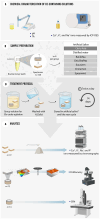Essential oil-containing solutions (mouthwashes) preserve dental enamel with releasing low Ca and P concentrations without morphology alterations: an in vitro study
- PMID: 38482175
- PMCID: PMC10933047
- DOI: 10.3389/fchem.2024.1341769
Essential oil-containing solutions (mouthwashes) preserve dental enamel with releasing low Ca and P concentrations without morphology alterations: an in vitro study
Abstract
Introduction: The use of natural products such as essential oils has been suggested due to their promising pharmacological effects and economic viability. This study aimed to determine hydrogenic potential (pH), titratable acidity (TA), and ion concentrations of five solutions containing essential oils (EO), when used as a EO-containing solutions, and evaluate ion concentrations, enamel surface loss, and morphology alterations in enamel. Materials and methods: The pH, TA, calcium (Ca), potassium (K), and sodium (Na) concentrations of five EO-containing solutions were measured. Bovine enamel specimens were submitted to two daily 30-s immersions in artificial saliva, citric acid, distilled water, BaCloTea (Basil, Clove e Tea Tree), GeLaTeaPep (Geranium, Lavender, Tea Tree and Peppermint), EucaLem (Eucalyptus and Lemon), Cinnamon, or Spearmint solutions for 14 days. Ca, K, Na, and phosphorus (P) were quantified through ions chromatography, enamel surface loss was determined by profilometry, and surface morphology was qualitatively analyzed through scanning electron microscopy. Data were submitted to one-way ANOVA and Tukey (p < 0.05). Results: The five EO-containing solutions presented significantly lower pH values than distilled water (p < 0.05). The GeLaTeaPep group presented a significantly higher TA value than BaCloTea (p < 0.05), which in turn showed a significantly higher TA value than the other solutions (p < 0.05). The distilled water presented significantly higher Ca, K, and Na concentrations than all EO-containing solutions (p < 0.05). The enamel exposed to EO-containing solutions showed lower Ca and P concentrations than artificial saliva (control) as well as significantly higher surface loss; however, the surface morphology was similar to the artificial saliva. Conclusion: EO-containing solutions have low pH, TA, and low concentrations of Ca, Na, and K. Moreover, enamel exposed to these solutions showed low Ca and P concentrations and slight surface loss without morphology alteration.
Keywords: calcium; chromatography; dental enamel; oils; scanning electron microscopy; volatile.
Copyright © 2024 Mutran, Carvalho-Filho, Ribeiro, Faial, Lima and D’Almeida Couto.
Conflict of interest statement
The authors declare that the research was conducted in the absence of any commercial or financial relationships that could be construed as a potential conflict of interest.
Figures



Similar articles
-
Erosive potential of powdered juice drinks on dental enamel.Gen Dent. 2021 Jan-Feb;69(1):44-49. Gen Dent. 2021. PMID: 33350955
-
Chemical composition and morphology study of bovine enamel submitted to different sterilization methods.Clin Oral Investig. 2018 Mar;22(2):733-744. doi: 10.1007/s00784-017-2148-5. Epub 2017 Jun 30. Clin Oral Investig. 2018. PMID: 28667399
-
Effect of olive oil and an olive-oil-containing fluoridated mouthrinse on enamel and dentin erosion in vitro.Acta Odontol Scand. 2007 Nov;65(6):357-61. doi: 10.1080/00016350701771843. Acta Odontol Scand. 2007. PMID: 18071958
-
The effect of saliva substitutes on enamel erosion in vitro.J Dent. 2014 Jun;42(6):720-5. doi: 10.1016/j.jdent.2014.03.012. Epub 2014 Apr 3. J Dent. 2014. PMID: 24705070
-
Carbohydrate-electrolyte drinks exhibit risks for human enamel surface loss.Restor Dent Endod. 2016 Nov;41(4):246-254. doi: 10.5395/rde.2016.41.4.246. Epub 2016 Aug 16. Restor Dent Endod. 2016. PMID: 27847745 Free PMC article.
References
LinkOut - more resources
Full Text Sources

